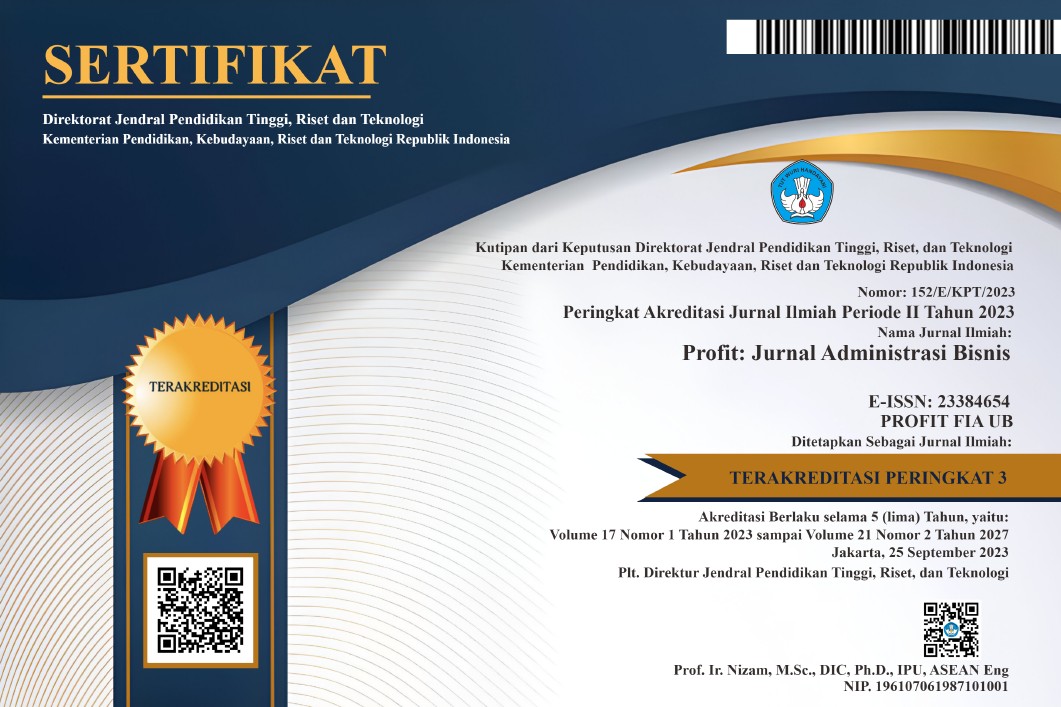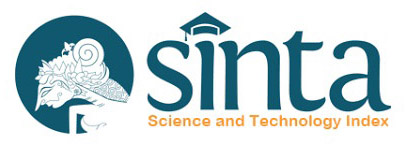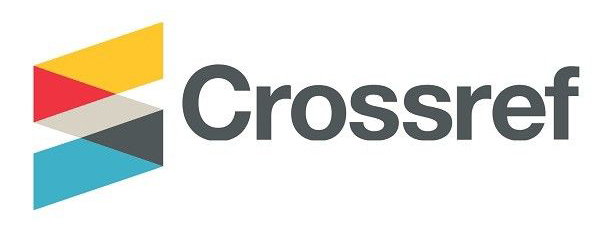PENGARUH EKSPEKTASI USAHA TERHADAP HEDONIC MOTIVATION, HABIT DAN NIAT PERILAKU PENGGUNAAN APLIKASI TRANSPORTASI ONLINE (Studi Pada Pelanggan Gojek Indonesia Di Kota Malang)
DOI:
https://doi.org/10.21776/ub.profit.2020.014.02.10Keywords:
Effort Expectancy, Hedonic Motivation, Habit, Behavior Intention, Transportation ApplicationAbstract
The development of the internet which is integrated with the smartphone application technology has made the business of transportation service innovate by adopting online transportation applications. Online transportation applications are important to know whether the technology is really accepted by users. This paper provides literature  for use as a reference in research into the acceptance and use of information technology with the UTAUT2 model. GOJEK is an online transportation application that provides solutions and convenience in daily activities. In fact, the desire to use the GOJEK application is not only because of the need for convenience, but also because of the urge to get pleasure and habits using the GOJEK application in daily activities. In proving the statement, this research builds a conceptual model and hypothesis formulation that is used to conduct research on the use of online transportation applications. This study will use sample of 130 customers who have used the GOJEK application for 1 or 3 months, then the data will be processed using PLS.
References
Aarts, H., Paulussen, T., & Schaalma, H. (1997). Physical exercise habit: On the conceptualization and formation of habitual health behaviours. Health Education Research. https://doi.org/10.1093/her/12.3.363
Ajzen, I., & Fishbein, M. (1980). Understanding attitudes and predicting social behaviour. Integration (Tokyo, Japan), (40), 27–29. https://doi.org/Z
Ajzen, Icek. (1988). Attitudes, personality, and behavior. 1988. Milton Keynes: Open University Press Google Scholar. https://doi.org/10.1037/e418632008-001
Alalwan, A. A., Dwivedi, Y. K., & Rana, N. P. (2017). Factors influencing adoption of mobile banking by Jordanian bank customers: Extending UTAUT2 with trust. International Journal of Information Management, 37(3), 99–110. https://doi.org/10.1016/j.ijinfomgt.2017.01.002
Arenas-Gaitán, J., Peral-Peral, B., & Ramón-Jerónimo, M. A. (2015). Elderly and internet banking: An application of UTAUT2. Journal of Internet Banking and Commerce, 20(1). https://doi.org/10.1007/978-3-531-92534-9_12
Asosiasi Penyelenggara Jasa Internet Indonesia. (2018). Infografis Penetrasi & Perilaku Pengguna Internet Indonesia. Teknopreuner.
Baptista, G., & Oliveira, T. (2015). Understanding mobile banking: The unified theory of acceptance and use of technology combined with cultural moderators. Computers in Human Behavior, 50, 418–430. https://doi.org/10.1016/j.chb.2015.04.024
Bhattacherjee, A. (2001). Understanding information systems continuance: An expectation-confirmation model. MIS Quarterly: Management Information Systems. https://doi.org/10.2307/3250921
BPS Kota Malang. (2018). Ht Tp S : // M Al a Ng Ko T B Ps Ht Tp S : Al Ko T B.
Cahya, P. (2018). 10 E-Commerce Terbaik yang Menggeser Eksistensi Toko Offline.
Chopdar, P. K., Korfiatis, N., Sivakumar, V. J., & Lytras, M. D. (2018). Mobile shopping apps adoption and perceived risks: A cross-country perspective utilizing the Unified Theory of Acceptance and Use of Technology. Computers in Human Behavior. https://doi.org/10.1016/j.chb.2018.04.017
DailySocial id. (2018). Startup Report. In DailySocial.
Davis, F. D., Bagozzi, R. P., & Warshaw, P. R. (1989). User Acceptance of Computer Technology: A Comparison of Two Theoretical Models. Management Science, 35(8), 982–1003. https://doi.org/10.1287/mnsc.35.8.982
DeLone, W. H., & McLean, E. R. (2003). The DeLone and McLean model of information systems success: A ten-year update. Journal of Management Information Systems. https://doi.org/10.1080/07421222.2003.11045748
DeLone, W., & McLean, E. (1992). Information System Success: The Quest for the Dependent Variable. Information Systems Research, 3(1), 60–65. https://doi.org/10.1287/isre.3.1.60
Escobar-RodrÃguez, T., & Carvajal-Trujillo, E. (2014). Online purchasing tickets for low cost carriers: An application of the unified theory of acceptance and use of technology (UTAUT) model. Tourism Management, 43, 70–88. https://doi.org/10.1016/j.tourman.2014.01.017
Gupta, A., Dogra, N., & George, B. (2018). What determines tourist adoption of smartphone apps?: An analysis based on the UTAUT-2 framework. Journal of Hospitality and Tourism Technology. https://doi.org/10.1108/JHTT-02-2017-0013
Herrero, Ã., San MartÃn, H., & Garcia-De los Salmones, M. del M. (2017). Explaining the adoption of social networks sites for sharing user-generated content: A revision of the UTAUT2. Computers in Human Behavior, 71, 209–217. https://doi.org/10.1016/j.chb.2017.02.007
Isaac, O., Abdullah, Z., Ramayah, T., & Mutahar, A. M. (2017). Internet Usage and Net Benefit among Employees Within Government Institutions in Yemen: An Extension of Delone and Mclean Information Systems Success Model (DMISM) with Task-Technology Fit. International Journal of Soft Computing, 12(3),178–198. https://doi.org/10.3923/ijscomp.2017.178.198
Mahendra, Y. A. S., Winarno, W. W., & Santosa, P. I. (2017). Pengaruh Perceived Security terhadap Pengadopsian In-App Purchase pada Aplikasi Mobile. Jurnal Nasional Teknik Elektro Dan Teknologi Informasi (JNTETI). https://doi.org/10.22146/jnteti.v6i2.313
Moore, G. C., & Benbasat, I. (1991). Development of an instrument to measure the perceptions of adopting an information technology innovation. Information SystemsResearch. https://doi.org/10.1287/isre.2.3.192
Morosan, C., & DeFranco, A. (2016). It’s about time: Revisiting UTAUT2 to examine consumers’ intentions to use NFC mobile payments in hotels. International Journal of Hospitality Management, 53, 17–29. https://doi.org/10.1016/j.ijhm.2015.11.003
Pillet, J. C., & Carillo, K. D. A. (2016). Email-free collaboration: An exploratory study on the formation of new work habits among knowledge workers. International Journal of Information Management. https://doi.org/10.1016/j.ijinfomgt.2015.11.001
Rogers, E. M. (1995). Elements of Diffusion. Diffusion of Innovations. https://doi.org/10.1007/978-94-010-9292-0
Silalahi, S. L. B., Handayani, P. W., & Munajat, Q. (2017). Service Quality Analysis for Online Transportation Services: Case Study of GO-JEK. Procedia Computer Science, 124,487–495. https://doi.org/10.1016/j.procs.2017.12.181
Venkatesh, V., Morris, M. G., Davis, G. B., & Davis, F. D. (2003). User Acceptance of Information Technology: Toward a unified view. MIS Quarterly, 27(3), 425–478. https://doi.org/10.1017/CBO9781107415324.004
Venkatesh, V., Thong, J., & Xu, X. (2012). Consumer Acceptance and User of Information Technology: Extending the Unified Theory of Acceptance and Use of Technology. MIS Quarterly, 36(1), 157–178. https://doi.org/10.1111/j.1365-2729.2006.00163.x
Wixom, B. H., & Todd, P. A. (2005). A theoretical integration of user satisfaction and technology acceptance. Information SystemsResearch. https://doi.org/10.1287/isre.1050.0042
Downloads
Published
Issue
Section
License
The copyright of the received article shall be assigned to the journal as the publisher of the journal. The intended copyright includes the right to publish the article in various forms (including reprints). The journal maintains the publishing rights to the published articles.

This work is licensed under a
Creative Commons Attribution-NonCommercial 4.0 International License

















